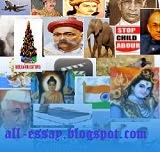
In India, there are several temples of 'Bal Ganesh', 'Bal Gopal', ‘Bal Krishna’, ‘Bal Hanuman’ ie Childhood of God. According to Hindu philosphy, a child is considered to be form of God. India is better known to be the country of Dhruv, Prahlad, Lav-Kush and Abhimanyu, the children having talents wisdom, intelligency and warriership. Apart from this, present day picture of poor Indian child is very dark. The poor child is the most neglected, most exploited and the most abused. Female child is the most deprived and under privileged of the whole class of such children. The girls are not only withdrawn from schools and forced to indulge in child labour but they are even dragged in the prostitution.
Child labour is violation of human rights and is considered to be a ‘necessary evil’ in any country in the whole world.. It hampers their normal and natural physical, mental, spritual, intellectual, emotional, moral and social development. Children are doing work as domestic servants. They are employed in hotels, workshops, service stations, shops, construction sites and pulling rickshaws etc. They are even working in hazardous and unhygienic forms of labour in manufacturing factories.
Article 24 of the Constitution of India, 1950 says, “No child below the age of fourteen years shall be employed to work in any factory or mine or employed in any hazardous employment”. Indian legislature has also enacted the Factories Act, 1948 , The Children Act, 1960, The Child Labour (Prohibition and Regulation) Act, 1986 etc. for the protection of rights of children. Article 45 of the Constitution of India, 1950 casts duty on the State to pendeavour to provide free and compulsory education to the children. Article 25(2) of the Universal Declaration of Human Rights also states about the special care and assistance for the motherhood and children.
For the past few years, work done by the Government of India and the States Government in this issue is praiseworthy. Many new schemes and policies are introduced for the education and betterment of the children. But, this problem is still in existence in India even though all these policies are available in India.
There may no other opinion that child labour should be restricted and if possible completely vanished. It is a socio-economic national problem, which requires close analysis and practical solutions to meet with this burning question.
Child labour is violation of human rights and is considered to be a ‘necessary evil’ in any country in the whole world.. It hampers their normal and natural physical, mental, spritual, intellectual, emotional, moral and social development. Children are doing work as domestic servants. They are employed in hotels, workshops, service stations, shops, construction sites and pulling rickshaws etc. They are even working in hazardous and unhygienic forms of labour in manufacturing factories.
Article 24 of the Constitution of India, 1950 says, “No child below the age of fourteen years shall be employed to work in any factory or mine or employed in any hazardous employment”. Indian legislature has also enacted the Factories Act, 1948 , The Children Act, 1960, The Child Labour (Prohibition and Regulation) Act, 1986 etc. for the protection of rights of children. Article 45 of the Constitution of India, 1950 casts duty on the State to pendeavour to provide free and compulsory education to the children. Article 25(2) of the Universal Declaration of Human Rights also states about the special care and assistance for the motherhood and children.
For the past few years, work done by the Government of India and the States Government in this issue is praiseworthy. Many new schemes and policies are introduced for the education and betterment of the children. But, this problem is still in existence in India even though all these policies are available in India.
There may no other opinion that child labour should be restricted and if possible completely vanished. It is a socio-economic national problem, which requires close analysis and practical solutions to meet with this burning question.

